Maneuvering unmarked trails demands meticulous preparation and the right tools to master the wilderness. Start with thorough terrain scrutiny via Google Earth and equip yourself with a GPS, a compass, and physical maps. Familiarity with topographical features and natural markers like ridgelines and rivers aids navigation. Use the sun's path and shadows for direction. Effective group dynamics enhance hiking safety, with leaders ensuring coordination and sweep hikers safeguarding against stragglers. Always carry emergency supplies, including a first aid kit, whistle, and extra batteries. For those keen to uncover the full suite of strategies and tools for successful hikes, there's more to grasp.
Key Takeaways
- Utilize physical maps and GPS devices for real-time tracking and backup navigation.
- Identify and use natural landmarks like rock formations and ridgelines for orientation.
- Employ waypoints and regular bearings to track progress accurately in unmarked areas.
- Join orienteering clubs to gain practical navigation experience and enhance skills.
- Prepare a comprehensive hike checklist and inform a trusted contact of your itinerary.
Preparing for the Hike
Before commencing a challenging hike, meticulous preparation is paramount to guarantee both enjoyment and safety.
Trail preparation begins with employing resources like Google Earth to gain an aerial perspective of the terrain, which helps in identifying key landmarks and potential route challenges. This virtual reconnaissance allows hikers to mentally map out the journey, enhancing their readiness for what lies ahead.
A thorough hike checklist is essential. It should include essential steps such as creating waypoints for important locations along the trail. These waypoints are indispensable for maintaining orientation, especially when traversing unfamiliar paths.
Additionally, ensuring that your GPS device is pre-loaded with maps facilitates real-time tracking, offering a digital safety net during the hike.
However, technology should not be solely relied upon. Carrying physical maps and a reliable compass as backup navigation tools is critical. Practicing compass skills beforehand will bolster your directional awareness, a significant skill if technology fails.
Moreover, informing a trusted contact of your hiking itinerary and expected return time provides an additional layer of safety, preparing for contingencies.
Essential Navigation Tools
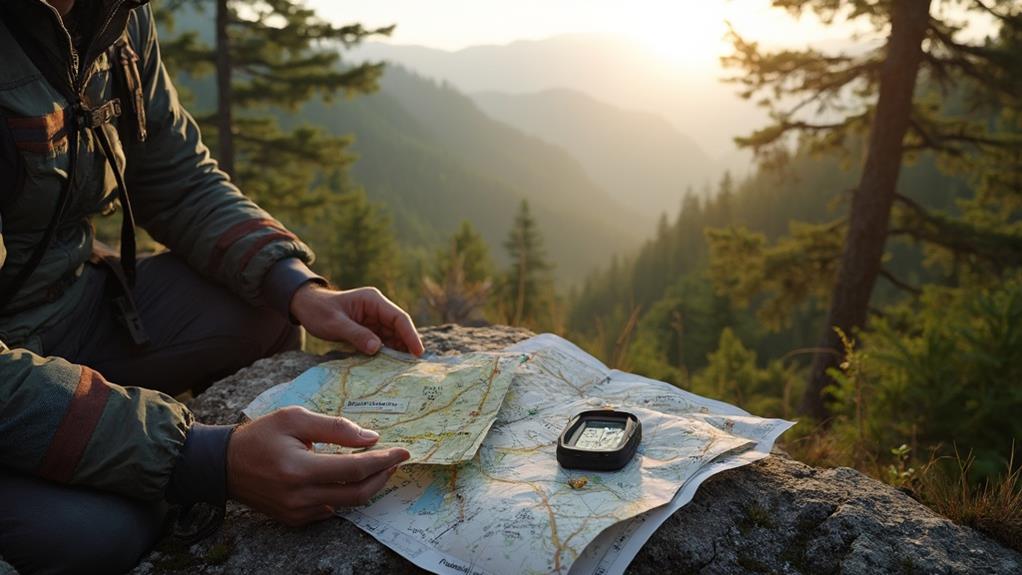
Maneuvering challenging hikes demands a thorough understanding of various tools that can guarantee both safety and success on the trail. Essential navigation tools are indispensable when traversing unmarked paths. GPS devices, with their superior GPS Accuracy, offer real-time tracking, ensuring hikers stay on course even in the absence of traditional signage. However, technology can falter; hence, Map Familiarization and Compass Skills are essential backup strategies.
Carrying a detailed physical map and a reliable compass can save the day when batteries deplete or signals fail. Incorporating Altimeter Usage into your toolkit provides significant insights into elevation changes, offering a deeper understanding of your surroundings and assisting in terrain navigation.
| Tool | Purpose | Key Benefit |
|---|---|---|
| GPS Device | Real-time location tracking | Enhances GPS Accuracy |
| Physical Map | Backup navigation | Aids in Map Familiarization |
| Wrist Altimeter | Monitor elevation changes | Elevation context |
Waypoint Planning is another strategic approach, allowing hikers to pre-set important locations, ensuring a clear path forward. For those seeking to refine their skills, joining orienteering clubs offers practical experience in Orienteering Techniques, equipping adventurers with the confidence to navigate even the most intimidating trails.
Using Natural Landmarks
Maneuvering challenging trails requires a keen eye for natural landmarks, which can provide invaluable guidance when traditional tools fall short.
By identifying key terrain features such as unique rock formations or ridgelines, hikers can establish reliable reference points to maintain their bearings.
Additionally, recognizing changes in the landscape, from seasonal vegetation shifts to the direction of flowing water, can further enhance a hiker's ability to stay on course and guarantee a safe journey.
Identifying Key Terrain Features
When commencing challenging hikes, a multitude of natural landmarks become invaluable tools for navigation and orientation. Understanding terrain features, such as hills, rivers, and distinctive rock formations, is essential in maintaining your course. By recognizing elevation changes, hikers can discern ridgelines and valleys, aiding in situational awareness.
Contour lines on topographic maps serve as a visual guide, illustrating these changes and allowing hikers to predict the landscape ahead. Attention to water flow direction in streams and rivers offers another layer of navigation insight. Water consistently flows downhill, providing a natural compass that can help confirm your position relative to the terrain.
This knowledge, combined with a keen observation of unique vegetation patterns, such as variations in tree density or flora types, becomes a powerful tool in remembering paths and pinpointing locations. These patterns often reflect underlying geographical shifts, subtly marking changes between ecosystems.
Moreover, animal trails or game paths frequently lead to critical resources like water sources or sheltered areas, naturally charting a route through dense foliage. By integrating these observations with a thorough understanding of natural landmarks, hikers can navigate confidently and safely, even when trails are unmarked or challenging.
Leveraging Natural Trail Markers
Amidst the challenges of unmarked trails, towering rock formations and ancient trees stand as steadfast guardians, guiding hikers through the wilderness. These natural markers serve as reliable waypoints, helping adventurers maintain their path while preserving trail sustainability. By observing prominent features like distinctive rock formations or large trees, hikers can anchor their routes in a landscape otherwise devoid of human signposts. Additionally, the strategic use of inukshuks—stone structures crafted in recognizable shapes—provides temporary guidance without causing environmental harm.
| Natural Marker | Example | Navigation Tip |
|---|---|---|
| Rock Formations | Unique cliffs or boulders | Use as landmarks on expansive terrains |
| Large Trees | Ancient, distinct trees | Mark turning points or decision areas |
| Water Bodies | Rivers or lakes | Orient using water flow direction |
| Animal Tracks | Deer or rabbit tracks | Follow cautiously as they may lead to water or shelter |
To further enhance orientation, hikers should utilize the sun's position and shadows as a natural compass. This technique, along with a keen awareness of topographical features such as ridgelines and valleys, empowers hikers to navigate with confidence. Observing these elements not only guarantees a safer journey but also contributes to the sustainability of the trails, minimizing the need for artificial markers.
Recognizing Landscape Changes
Building upon the wisdom of natural trail markers, recognizing landscape changes becomes an essential skill for hikers traversing unmarked paths. By honing the ability to observe distinctive natural landmarks such as rock formations, water bodies, and tree patterns, hikers can effectively use these elements as reference points to maintain their course.
These features, when understood within the broader context of landscape patterns, provide invaluable guidance in maneuvering unfamiliar terrain.
Elevation indicators, such as changes in vegetation or soil type, can reveal shifts in the terrain that might alter a hiker's route. For instance, the appearance of moisture-loving plants may indicate proximity to a water source or a lower elevation, while drier soil could suggest higher ground.
Additionally, the sun's position offers a reliable natural compass, with its predictable path from east to west aiding in orientation and time estimation.
Familiarity with topographical features like ridgelines, valleys, and drainages further enhances a hiker's ability to assess their surroundings and position relative to the terrain.
Documenting key landmarks through notes or photographs can be an essential strategy for retracing steps, ensuring a safe return if one strays from the intended path.
Effective Trail Marking

Steering through the complexities of challenging hikes demands thoughtful and effective trail marking, where the balance between guidance and environmental stewardship is essential. Utilizing natural markers such as rocks and sticks provides a sustainable way to indicate trail direction without harming the environment. Conversely, manufactured materials, like neon tape, disrupt local ecosystems and should be avoided. Instead, biodegradable materials, such as eco-friendly flagging tape, are recommended for temporary marking. It's vital to remove all markers post-hike to respect Leave No Trace principles.
Inukshuks, the stone structures traditionally used by Indigenous peoples, offer an ingenious method for creating visible markers. Their construction requires minimal disturbance to the terrain, reflecting a commitment to preserving the natural beauty and integrity of the hiking environment. Additionally, understanding local wildlife is paramount; food-based markers can inadvertently attract animals, posing risks to both hikers and wildlife.
| Trail Marking Method | Benefits |
|---|---|
| Natural Markers | Eco-friendly, no permanent impact |
| Biodegradable Materials | Leave No Trace adherence |
| Inukshuks | Visible, culturally respectful |
Responsible trail marking not only aids navigation but also inspires a culture of environmental responsibility, encouraging others to adopt sustainable practices while exploring unmarked trails.
Understanding Group Dynamics
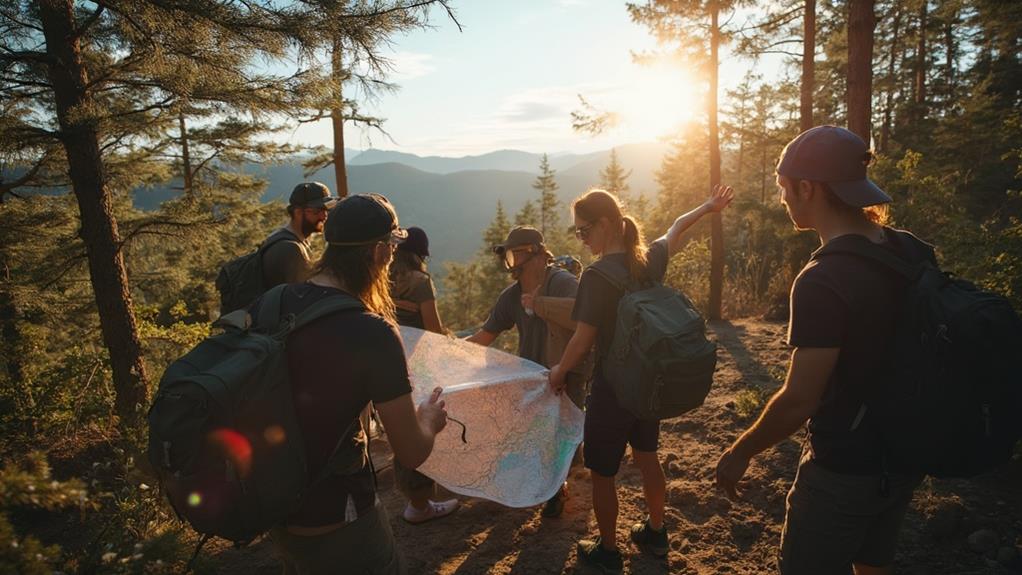
Maneuvering challenging hikes with a large group requires strategic planning and effective communication techniques to guarantee everyone's safety and enjoyment.
Appointing leadership and responsibility roles, such as a leader and a sweep hiker for each subgroup, not only enhances coordination but also fosters a sense of accountability among participants.
Effective Communication Techniques
Amid the unpredictable challenges of hiking, establishing effective communication techniques is vital for understanding group dynamics and guaranteeing safety. Active listening and verbal cues play significant roles in maintaining open lines of communication among group members. By engaging in active listening, hikers can better understand and respond to each other's concerns and ideas, thereby fostering a cohesive group environment.
Verbal cues, such as calling out potential hazards or suggesting breaks, help confirm that everyone is aware of the route and any changes in plans.
Designating a leader and a sweep hiker is essential, particularly in larger groups or on challenging trails. The leader navigates the group forward, while the sweep guarantees no one is left behind, maintaining group cohesion. Establishing clear regrouping points and guidelines for navigation responsibilities helps facilitate smooth changes and minimizes confusion.
In areas with poor cell service, short-range radios prove invaluable for effective coordination, confirming that all group members remain connected, particularly in emergencies.
Encouraging basic navigation skills among all participants enhances overall safety, allowing each member to contribute confidently to the group's journey. These practices are fundamental to successful and safe hiking experiences on unmarked trails.
Leadership and Responsibility Roles
Building on the foundation of effective communication, the roles of leadership and responsibility become indispensable in steering through challenging hikes. Designating a clear leader is essential; this person sets the pace, makes navigation decisions, and guarantees that the group adheres to the planned route.
Complementing this role is the sweep hiker, who stays at the back to confirm no one is left behind, a fundamental aspect of responsibility sharing that safeguards the group's cohesion.
Leadership styles vary, but successful leaders on the trail often balance assertiveness with empathy, understanding each member's pace and ability. This adaptability is significant when splitting larger groups into smaller, manageable teams, a strategy that enhances safety and facilitates better navigation.
Each subgroup should ideally not exceed eight members, guaranteeing effective communication and quick decision-making. Regrouping points marked along the trail serve as checkpoints, allowing leaders to assess the group's status and reinforce navigation responsibilities.
Every member, equipped with basic navigation skills, contributes to these dynamics, ensuring informed decisions that prioritize safety. Understanding these roles fortifies the group's structure, fostering a cooperative atmosphere essential for overcoming the unpredictable challenges of unmarked trails.
Safety and Coordination Strategies
A seasoned hiker knows that a robust safety and coordination strategy is akin to a compass guiding a group through the intricate tapestry of a challenging hike. Understanding group dynamics is essential, particularly when maneuvering unmarked trails with large groups.
For parties exceeding 20 members, dividing into smaller subgroups enhances safety and improves communication strategies. Each subgroup should have a designated leader and sweep hiker to maintain order and guarantee no one is left behind.
Establishing clear guidelines for regrouping at predetermined locations is fundamental. Assigning navigation responsibilities within these subgroups assures everyone is informed of the route and timeline.
Utilizing short-range radios in areas with poor cell service is an effective communication strategy, allowing coordination among members, especially when cell service is unreliable. It is imperative for at least one experienced navigator to be present in each subgroup to guide the way.
Monitoring the pace of each group helps prevent members from straying, while regular communication keeps all participants engaged and informed.
Encouraging all members to develop basic navigation skills before the hike enhances safety and decision-making, fostering a well-coordinated and successful journey through challenging terrains.
Navigating Bushwhacking
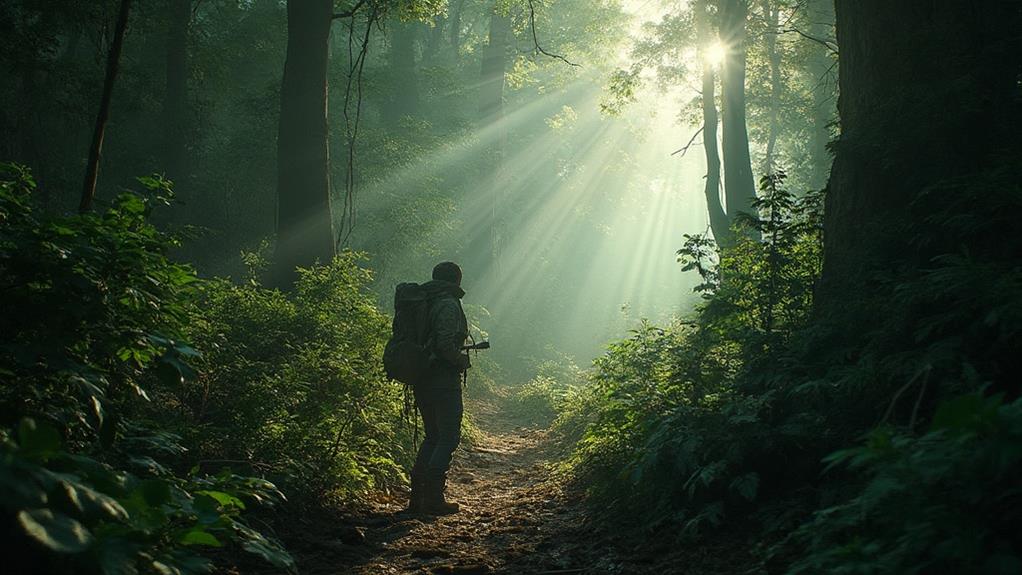
Bushwhacking, the art of traversing unmarked and rugged terrains, demands meticulous preparation and in-depth knowledge of the landscape. Engaging in bushwhacking strategies, one must conduct a thorough terrain assessment before setting off. This involves studying physical maps and digital tools to anticipate dense vegetation and uneven ground that standard maps may not reveal. These strategies are essential for identifying potential hazards and planning a feasible route through the wilderness.
Recognizing natural features such as ridgelines and drainages is an important bushwhacking strategy, as these often serve as natural guides. Trails frequently align with these features, offering hikers a strategic advantage in navigation. Employing waypoints and regular bearings guarantees hikers can track their progress accurately. Additionally, identifying significant landmarks enhances navigation by providing reliable reference points amid the unmarked expanse.
To conquer the unpredictability of bushwhacking, carrying important navigational gear like a detailed map, compass, and GPS device is non-negotiable. These tools are instrumental in orienting oneself in the absence of visible trails.
Moreover, having a contingency plan and confirming all participants are versed in navigation techniques is essential. Such preparedness not only bolsters success but also assures safety in the wild.
Safety Equipment Essentials

Starting on challenging hikes requires meticulous preparation, with safety equipment being paramount to guarantee a secure journey.
Key navigation tools such as a reliable GPS device, complemented by traditional map and compass, form the backbone of any hiker's toolkit, while essential emergency supplies like a fully stocked first aid kit and a whistle provide critical support in unforeseen situations.
Equipping yourself with these essentials not only enhances your ability to navigate and respond to emergencies but also fortifies your confidence to explore the uncharted paths safely.
Must-Have Navigation Tools
Maneuvering through the wilderness on challenging hikes requires not only physical endurance but also the right set of tools to guarantee safety and precision. Among these, GPS technology stands as a cornerstone for modern navigation, allowing hikers to access real-time location tracking even on the most unmarked trails.
However, technology's reliability hinges on preparedness; extra batteries are a must to avert power failures that could leave you stranded.
Yet, reliance solely on electronic devices can be precarious. A physical map and compass are indispensable back-ups, serving as timeless tools that assure you remain oriented if technology falters. Enhancing your directional skills with these tools is vital, and joining orienteering clubs can provide practical experience, boosting both confidence and competence.
Altitude awareness is another essential aspect, especially in mountainous terrains where elevation can drastically alter your perception of the landscape. A wrist altimeter can effectively track elevation changes, offering valuable insights that complement your navigational strategy.
Incorporating these must-have navigation tools into your hiking regimen not only enhances safety but also enriches the experience, transforming intimidating trails into manageable paths of exploration and adventure.
Essential Emergency Supplies
Steering through the unpredictability of challenging hikes demands meticulous preparation, particularly when it comes to emergency supplies. Every seasoned hiker knows that the wilderness is as unforgiving as it is beautiful. A well-equipped first aid kit is indispensable, containing essentials such as bandages, antiseptics, and pain relief medication to swiftly address injuries. These items can prevent minor mishaps from becoming major setbacks when trekking through unmarked trails.
Equally essential is a reliable multi-tool or knife. This versatile piece of equipment can tackle a multitude of tasks, from repairing gear to preparing food, and even fashioning makeshift solutions in unexpected scenarios. Its utility is unmatched when facing the unknown.
In addition to these tools, a whistle serves as a critical signaling device. Its sound can pierce through the thickest of forests, reaching rescuers when voice fails. A foil survival blanket, though seemingly simple, can be a lifesaver, retaining important body heat during sudden drops in temperature.
Lastly, keeping communication devices operational is paramount. Extra batteries and a portable charger guarantee that you stay connected, ready to call for help at a moment's notice.
In the wild, preparation is your greatest ally.
Reading and Interpreting Maps
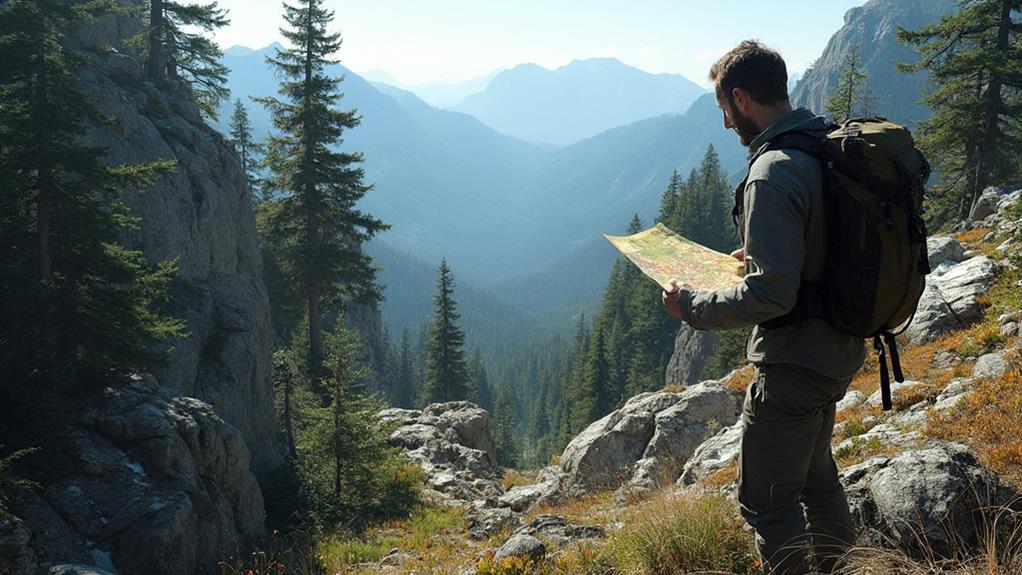
Reading and interpreting maps is a vital skill for hikers traversing through challenging terrains. Topographic maps, with their detailed depiction of elevation changes and terrain types, serve as invaluable tools for understanding the physical characteristics of the area. These maps are rich with map symbols and legends that denote trails, water bodies, and navigational aids specific to the region. Familiarity with these symbols is fundamental for effective navigation.
Mastering orientation techniques is equally important. Using a compass to align the map to true north guarantees that the direction of travel aligns with the depicted features. This practice aids in maintaining a correct course and avoiding potential misdirection.
As you progress, landmark identification becomes a vital skill. Recognizing peaks, valleys, and rivers on the map as reference points allows for continuous route verification. This process reassures you of your current position and guides you in making precise trail adjustments.
Regular map consultation, especially at trail intersections, helps to confirm your path and adapt to changing conditions. Such vigilance not only enhances safety but also enriches the hiking experience, empowering you to navigate unmarked trails with confidence and certainty.
Strategies for Getting Unlost
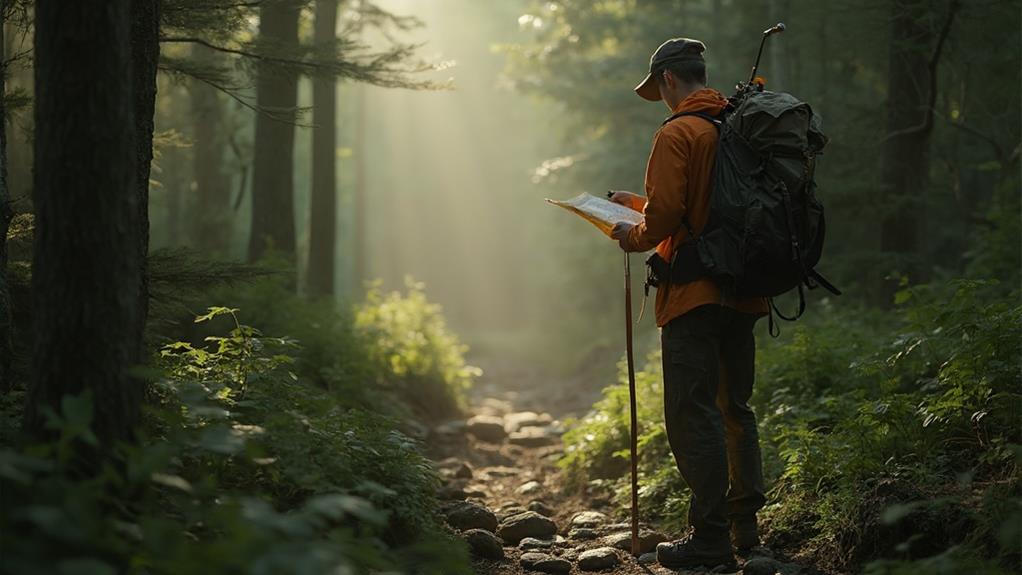
Steering through the complexities of unmarked trails requires a strategic approach to guarantee safety and reliability. Mental preparedness and situational awareness are your greatest allies when faced with the intimidating challenge of getting unlost in wilderness settings.
Before setting out, familiarize yourself with the terrain and natural features. This foundational knowledge supports your ability to navigate effectively, enhancing both confidence and safety.
Equipped with a compass, topographic maps, and GPS devices, hikers can maintain orientation and track progress. These tools are invaluable for creating waypoints at key locations and taking bearings at junctions, which aids in retracing steps if disoriented.
Should you find yourself lost, the first rule is to remain calm. This mental preparedness allows for clear thinking and decision-making. Assess your surroundings carefully—utilize landmarks or navigation tools to guide you back to the last known location.
Regularly checking environmental cues and landmarks is essential. Situational awareness enables hikers to notice terrain changes or unexpected obstacles, prompting necessary route adjustments.
Enhancing Your Skills

What steps can you take to enhance your hiking experience from a simple endeavor to a skillful expedition? Raise your outdoor adventures by investing in skill development and practice techniques that guarantee both safety and enjoyment on unmarked trails.
Start by familiarizing yourself with the terrain and features of your intended hike. Understanding the topography aids in navigation and critical decision-making when trail markers are absent. Equip yourself with a compass and topographic maps, and practice using these tools to maintain orientation and determine direction confidently.
Consider joining an orienteering club or enrolling in navigation courses. These avenues provide hands-on experience necessary for mastering unmarked trails. Regularly carrying GPS devices, loaded with maps, complements your skill set, but never underestimate the value of physical maps and extra batteries as reliable backups.
To further enhance your navigation abilities, engage in practice techniques in familiar areas, gradually progressing to more challenging environments as your confidence grows.
Here are steps to bolster your experience:
- Familiarize with terrain and features
- Practice compass and map reading
- Join orienteering clubs
- Carry GPS with backup maps
- Gradually tackle challenging trails
Each step solidifies your ability to navigate confidently and safely.
Frequently Asked Questions
What Is the Most Common Mistakes First Time Hikers Make?
First-time hikers frequently underestimate trail difficulty, neglect essential gear preparation, and overlook trail etiquette. This often leads to inadequate navigation tools, unawareness of weather conditions, and failure to inform others of plans, posing significant safety risks.
Which Situation Should Hikers Avoid?
Hikers should avoid venturing alone on unmarked trails and steering in poor weather conditions. These scenarios greatly increase the risk of hiking emergencies, compromising trail safety and potentially leading to disorientation, injury, or prolonged exposure to harsh environments.
How Do You Not Leave a Trail in the Woods?
To avoid leaving a trail in the woods, adhere to Leave No Trace principles, practicing Trail Etiquette by removing temporary markers, ensuring Wildlife Awareness by minimizing disturbances, and emphasizing Route Planning to maintain the natural environment for future explorers.
What to Do if You Get Stuck on a Hike?
If stranded during a hike, prioritize safety by remaining calm. Utilize navigation tools such as maps and compasses to retrace steps. If disoriented, stay put, conserve energy, and use visible signals to aid rescuers in locating you efficiently.
Conclusion
In the endeavor of traversing unmarked trails, preparation and knowledge are paramount. The integration of essential navigation tools, the strategic use of natural landmarks, and effective trail marking contribute greatly to maintaining direction. A thorough understanding of group dynamics and the deployment of appropriate safety equipment further guarantee security. Mastery in reading and interpreting maps, alongside strategies for reorienting when disoriented, are crucial. Continual skill enhancement remains essential for successfully traversing challenging hikes with confidence and safety.